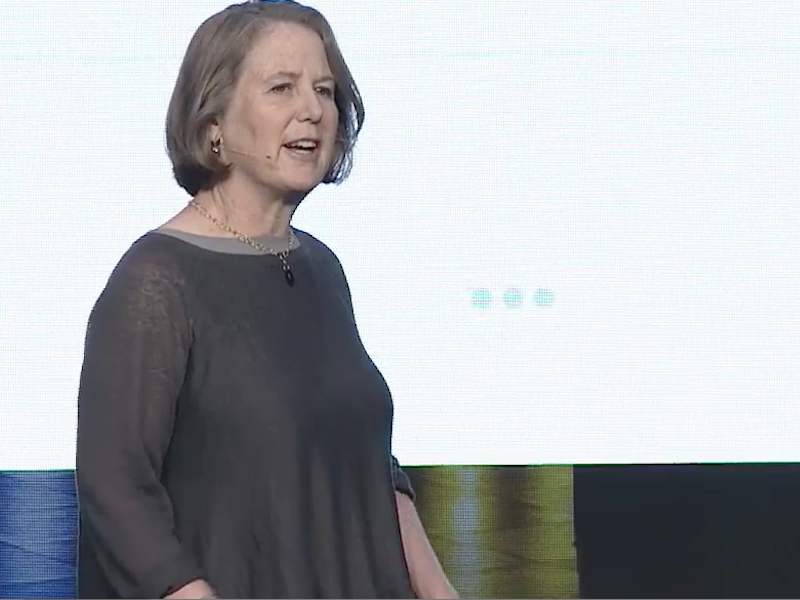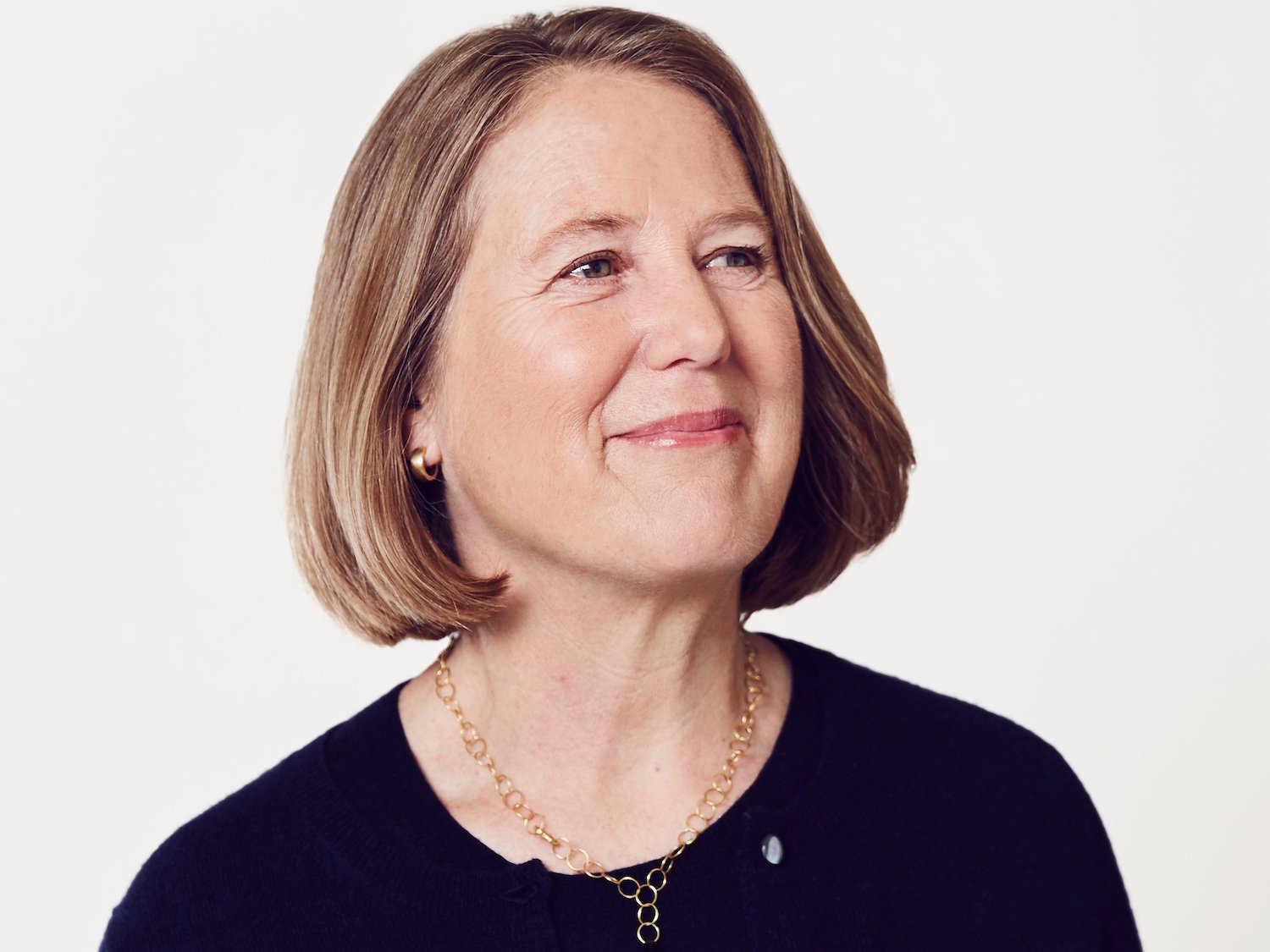
Google cloud boss Diane
Greene.
Google
The first thing to understand about Diane Greene, the woman
Google acqui-hired in November to transform its fragmented cloud
business, is that she has the mind of an engineer.
Cool technology, elegantly designed and built, lights her up.
Even her jokes tend to be geek oriented.
A lifelong competitive sailor, she was a mechanical engineer who
built boats and windsurfers before she became an iconic Silicon
Valley computer scientist.
The second thing to understand about her is that she hates the
limelight.
While she’s fine with standing on stage talking about all the
cool things Google is building for their new target customer, big
companies, she prefers not to talk about herself.
In fact, she’s so ego-free, her office at Google’s Mountain View,
California, headquarters is just a tiny windowless room, big
enough to hold an ordinary desk and two chairs.

Diane
Greene.
Business
Insider
Before she took the job, Google had been building products and
pursuing business customers in a sort of hodgepodge way. Its
Google for Work unit had Google Apps, Chromebooks, and an
assortment of other products like videoconferencing.
It had poached Amit Singh from Oracle a few years back to help
turn Google Apps into a more professional business unit, capable
of taking on Microsoft Office. He had hired salespeople and
created a support organization. (He’s since
moved on to work for Google’s young virtual-reality unit.)
But Google for Work wasn’t working very closely with Google’s
nascent cloud-computing business, running under Urs
Hölzle.
That unit included a huge cadre of people running Google’s
data centers (600 computer-security experts alone, for instance),
but only a small
separate sales force.
In the seven months since Greene came in that’s
changed. She:
-
hired experienced enterprise sales and support
personnel. -
created the office of the CTO, which handles the
technical questions, design, or customization of large customer
needs. -
created units that focus on specific industries,
because
an agriculture firm has different needs
than a retailer. -
created programs for getting more “reseller” partners on
board, the small consultants who will sell and support Google’s
cloud to smaller customers, offering niche services. -
created a Global Alliance program for working with big
global partners.
“So these are all new,” Greene tells us.
Now all the teams are working together. “We all get together once
a week, we share and discuss and debate,” she says. “It wasn’t
possible before I came because sales and marketing were in a
different division than cloud. And cloud was in a different
division than Apps. I feel like the structure is in place now and
we’re hiring very aggressively.”
Hölzle wooed her to the job
Greene made her name as cofounder of VMware, with her famous
Stanford professor husband, Mendel Rosenblum. VMware
has gone on to become a giant tech company. She left the VMware
CEO role about eight years ago, after EMC bought it.

Urs
Hölzle.
Google+
Until taking this Google job, she was quietly doing her own
thing, raising her kids, advising and angel investing in startups
(many of which
did spectacularly well), and serving on a few boards,
including Google’s board since 2012. She was under the radar but
still highly and widely respected, the queen of enterprise
computing.
She was also working on a new startup, Bebop Technologies, until
Google bought it for $380 million when it hired her. Greene’s
take was $149 million, and
she and her husband dedicated that money to charity.
Hölzle, the engineer who famously built Google’s data centers and
runs the technical side of the cloud business, is Greene’s
partner.
He believes that within a few years, Google’s
cloud business can be bigger than its ad business. That’s a
big goal: Google currently makes the vast majority of its $75
billion in annual revenue from ads.
Hölzle is the one who talked Greene into taking this job as
they hung out walking their dogs together.
“Through being on the board, I got to know Urs and started
working with him informally,” Greene says.
“We knew we needed an overall business leader. He’s
a brilliant person and fun to work with. He really wanted to me
to do it. I just realized, wow, partnering with Urs, we can
really do this, with the backdrop of Google which is just this
amazing company,” she says.
A new phenom
Google has placed itself at the center of one of the biggest,
newest trends happening in the enterprise market. Some people
call this trend digital transformation. But it’s more than just
automating manual processes or turning paper forms into iPad
apps.
 Flickr/Amanda Parsons
Flickr/Amanda Parsons
More and more, the IT departments at large companies have started
treating their tech vendors as partners that help them cocreate
the tech they need.
“This is new for me. I’ve never been in the enterprise where your
customers are your partners. It was always, you had customers and
you had partners. But almost every customer of a certain size is
a partner. It’s going both ways now,” Greene says.
She points to one customer, Land O’Lakes, as an example.
Land O’Lakes is probably best known for its butter and dairy
products. It took crop and weather data from Google and worked
with Google to build an app hosted on Google’s cloud. The app
helps its farm and dairy co-op members improve their crop yields.
“It’s fun for us to help them do that,” she says. Unlike the old
days, where an IT company would be the one to build the app and
sell it to agriculture companies, “we don’t have to do it
ourselves.”
‘More and more’
This idea of partnering with customers is the key to her
strategy.

Google Photos understand
the image in the photo.
Tim
Stenovec/Business Insider
“For me, this is such a revolution,” she says. “Everything is
changing now that we are in the cloud in terms of sharing our
data, understanding our data using new techniques like machine
learning.”
Google’s competitive strength, Greene believes, is the breadth of
the tech it can offer an enterprise.
Enterprise-app developers can tap into things like Maps, Google’s
computer-vision engine (the tech that powers Google Photos),
weather data, and language/translation/speech recognition. They
can build apps on top of Google’s Calendar, documents,
spreadsheet and presentation apps.
And, under Greene’s new integrated organization, they can even
tap into the tech that powers Google’s ads or YouTube, search, or
its many other services.
“And we’re going to have more and more,” she says.
When a company can take its own data and combine it with all of
Google’s technology and Google’s data, “there’s just huge
possibilities,” she says.
![]() Google
Google
Greene will tell you, “We’re the only public cloud company with
all of that.”
When pointing out that Microsoft also offers a computer vision
API, translation services, and APIs for Office 365, and that IBM
also offers weather data and language services, and so on,
Greene’s got a comeback ready.
“We have Chromebooks.”
Well, Microsoft has Surface.
“But Chromebooks can run all the Android apps, are totally
secure, they have administration … and they have a nice
keyboard,” she laughs.
In fact, Greene says, “I only use a Chromebook now. I never
thought I could do that but I love it.”
She’s watching Amazon
In truth, she’s not laser-focused on overtaking Microsoft, widely
considered the No. 2 cloud player, with Google trailing behind.
 Google
Google
She, like all the cloud vendors, are looking at market leader
Amazon Web Services, which is raking in the enterprise-cloud
customers.
AWS is even convincing
a growing number of them to shut down all of their data
centers and just rent everything from AWS. This
includes Intuit, the other company where
Greene is a board member.
AWS is so successful it’s
currently on track to do $10 billion in revenue this fiscal
year, and it’s also
Amazon’s most profitable business unit.
And it blows all the
competition out of the water in the sheer number of features on
its cloud, as well as its partner ecosystem.
So how is she going to beat Amazon? By offering better tech, she
says.
“I’m a little biased but I really do think, on the hard stuff,
we’re the world’s best cloud,” she says.

Diane Greene
Google
“I agree we have more features to do, although we have the basics
for enterprise that you need. We have more partners to bring on,
but we’re doing that very quickly. But the hard stuff, I do think
we’re the world’s best.”
While Greene would not share the cloud unit’s growth numbers, she
says that “growth is really good and we’re doing great stuff with
some really big customers.”
She adds: “We’ve been moving customers to our cloud both from
Amazon and on-prem.”
“On-prem” means getting companies to move the apps they have
running in their own computers on their own premises into
Google’s cloud.
Google has even been engaging Amazon with its price-cut war,
according to Greene. “They’ve been following our price cuts.
We’ve been initiating them,” she says.
She jokes, “We should make a T-shirt: ‘the highest quality,
lowest-cost cloud.'”
Article source: http://www.businessinsider.com/how-diane-greene-transformed-googles-cloud-2016-6
